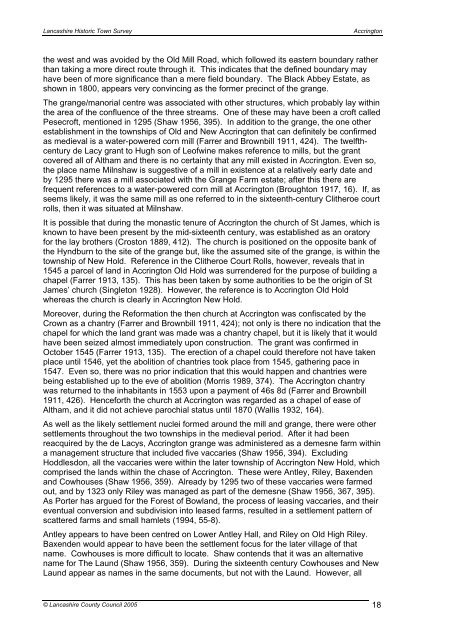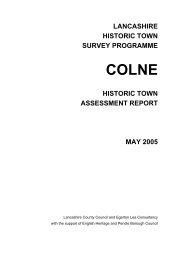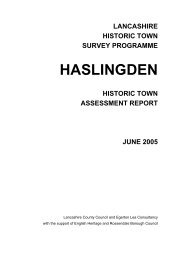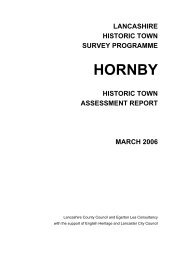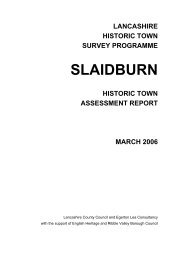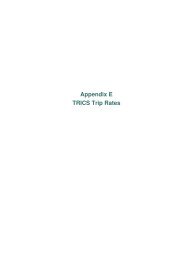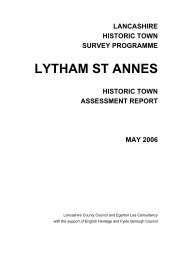ACCRINGTON - Lancashire County Council
ACCRINGTON - Lancashire County Council
ACCRINGTON - Lancashire County Council
Create successful ePaper yourself
Turn your PDF publications into a flip-book with our unique Google optimized e-Paper software.
<strong>Lancashire</strong> Historic Town Survey<br />
Accrington<br />
the west and was avoided by the Old Mill Road, which followed its eastern boundary rather<br />
than taking a more direct route through it. This indicates that the defined boundary may<br />
have been of more significance than a mere field boundary. The Black Abbey Estate, as<br />
shown in 1800, appears very convincing as the former precinct of the grange.<br />
The grange/manorial centre was associated with other structures, which probably lay within<br />
the area of the confluence of the three streams. One of these may have been a croft called<br />
Pesecroft, mentioned in 1295 (Shaw 1956, 395). In addition to the grange, the one other<br />
establishment in the townships of Old and New Accrington that can definitely be confirmed<br />
as medieval is a water-powered corn mill (Farrer and Brownbill 1911, 424). The twelfthcentury<br />
de Lacy grant to Hugh son of Leofwine makes reference to mills, but the grant<br />
covered all of Altham and there is no certainty that any mill existed in Accrington. Even so,<br />
the place name Milnshaw is suggestive of a mill in existence at a relatively early date and<br />
by 1295 there was a mill associated with the Grange Farm estate; after this there are<br />
frequent references to a water-powered corn mill at Accrington (Broughton 1917, 16). If, as<br />
seems likely, it was the same mill as one referred to in the sixteenth-century Clitheroe court<br />
rolls, then it was situated at Milnshaw.<br />
It is possible that during the monastic tenure of Accrington the church of St James, which is<br />
known to have been present by the mid-sixteenth century, was established as an oratory<br />
for the lay brothers (Croston 1889, 412). The church is positioned on the opposite bank of<br />
the Hyndburn to the site of the grange but, like the assumed site of the grange, is within the<br />
township of New Hold. Reference in the Clitheroe Court Rolls, however, reveals that in<br />
1545 a parcel of land in Accrington Old Hold was surrendered for the purpose of building a<br />
chapel (Farrer 1913, 135). This has been taken by some authorities to be the origin of St<br />
James’ church (Singleton 1928). However, the reference is to Accrington Old Hold<br />
whereas the church is clearly in Accrington New Hold.<br />
Moreover, during the Reformation the then church at Accrington was confiscated by the<br />
Crown as a chantry (Farrer and Brownbill 1911, 424); not only is there no indication that the<br />
chapel for which the land grant was made was a chantry chapel, but it is likely that it would<br />
have been seized almost immediately upon construction. The grant was confirmed in<br />
October 1545 (Farrer 1913, 135). The erection of a chapel could therefore not have taken<br />
place until 1546, yet the abolition of chantries took place from 1545, gathering pace in<br />
1547. Even so, there was no prior indication that this would happen and chantries were<br />
being established up to the eve of abolition (Morris 1989, 374). The Accrington chantry<br />
was returned to the inhabitants in 1553 upon a payment of 46s 8d (Farrer and Brownbill<br />
1911, 426). Henceforth the church at Accrington was regarded as a chapel of ease of<br />
Altham, and it did not achieve parochial status until 1870 (Wallis 1932, 164).<br />
As well as the likely settlement nuclei formed around the mill and grange, there were other<br />
settlements throughout the two townships in the medieval period. After it had been<br />
reacquired by the de Lacys, Accrington grange was administered as a demesne farm within<br />
a management structure that included five vaccaries (Shaw 1956, 394). Excluding<br />
Hoddlesdon, all the vaccaries were within the later township of Accrington New Hold, which<br />
comprised the lands within the chase of Accrington. These were Antley, Riley, Baxenden<br />
and Cowhouses (Shaw 1956, 359). Already by 1295 two of these vaccaries were farmed<br />
out, and by 1323 only Riley was managed as part of the demesne (Shaw 1956, 367, 395).<br />
As Porter has argued for the Forest of Bowland, the process of leasing vaccaries, and their<br />
eventual conversion and subdivision into leased farms, resulted in a settlement pattern of<br />
scattered farms and small hamlets (1994, 55-8).<br />
Antley appears to have been centred on Lower Antley Hall, and Riley on Old High Riley.<br />
Baxenden would appear to have been the settlement focus for the later village of that<br />
name. Cowhouses is more difficult to locate. Shaw contends that it was an alternative<br />
name for The Laund (Shaw 1956, 359). During the sixteenth century Cowhouses and New<br />
Laund appear as names in the same documents, but not with the Laund. However, all<br />
© <strong>Lancashire</strong> <strong>County</strong> <strong>Council</strong> 2005 18


